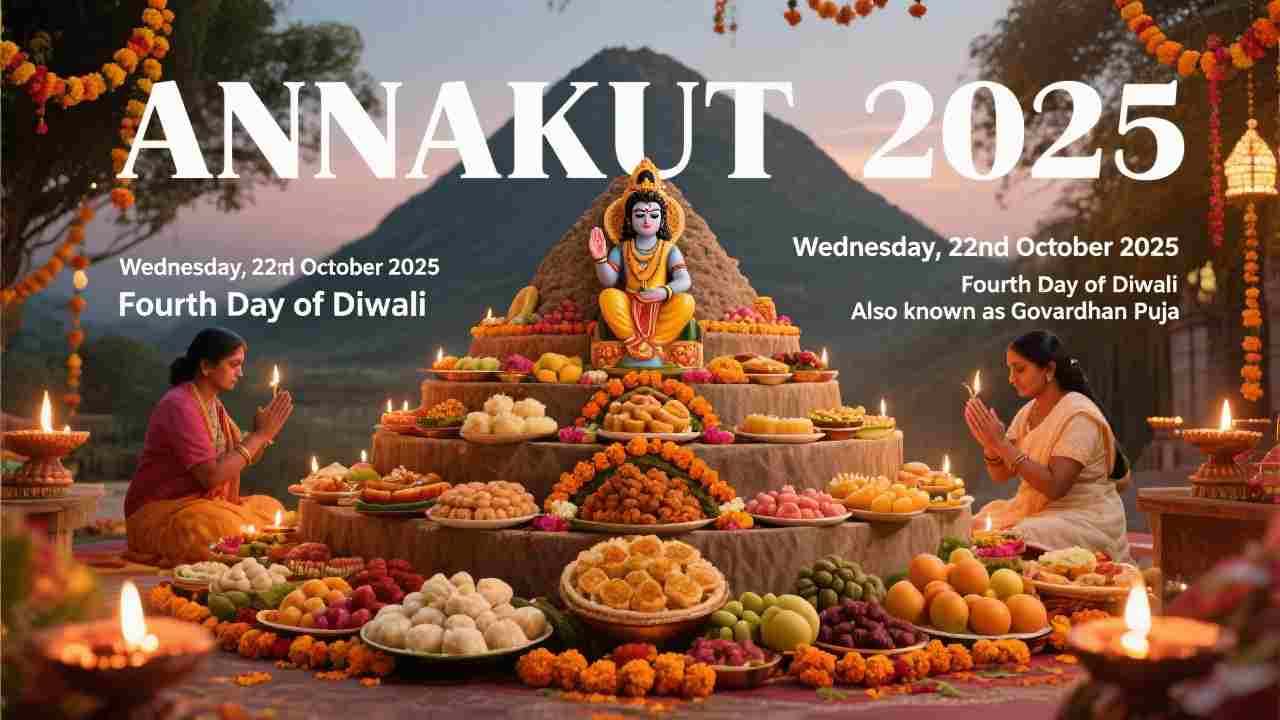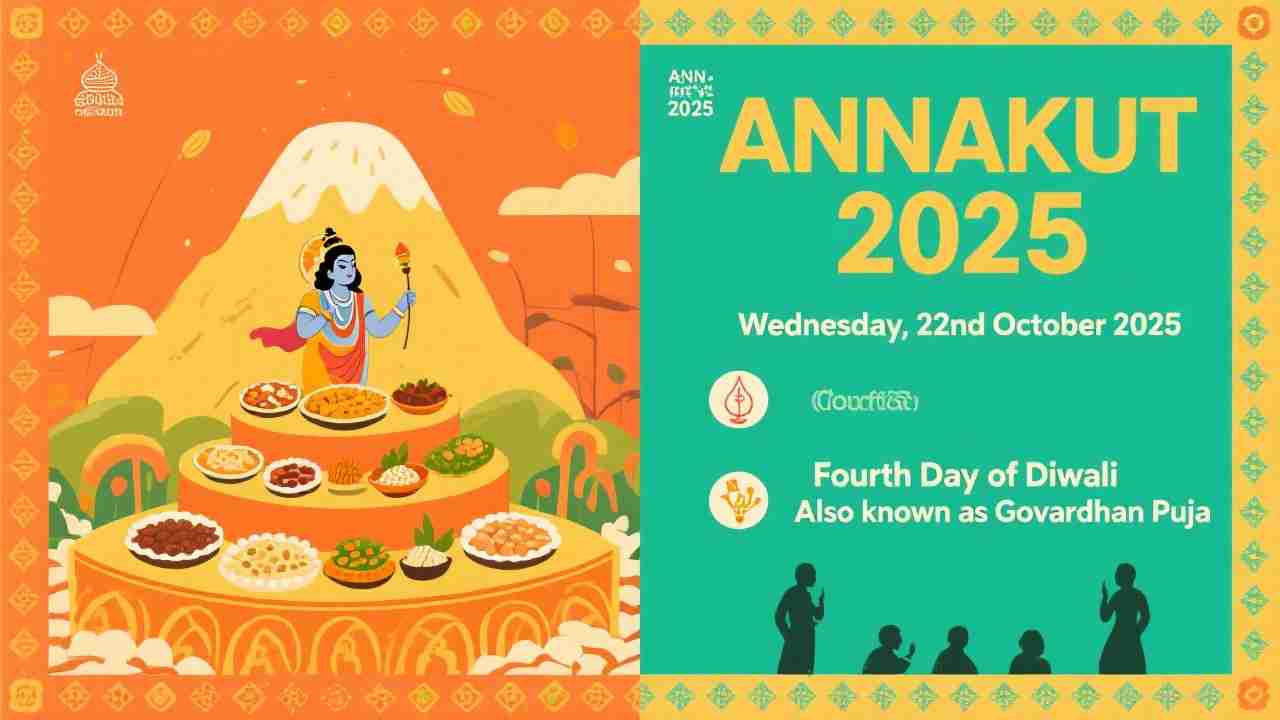
Have you ever witnessed a mountain of food, beautifully arranged in steps, offered with devotion to God? This breathtaking tradition is known as Annakut, one of the most unique celebrations in Hindu culture. On this day, devotees express their gratitude through rituals, cow seva, and the grand offering of hundreds of dishes, symbolizing abundance, humility, and the blessings of divine grace.
If you are wondering, when is Annakut in 2025, the answer is simple: Annakut will be celebrated on Wednesday, 22nd October 2025, marking the fourth day of Diwali, also known as Govardhan Puja.
In this blog, we’ll explore not only the date and rituals but also the history of Annakut, temple traditions, an Annakut items list, and its modern-day significance worldwide. By the end, you’ll see why this festival is more than food. It’s devotion in its most delicious form.
When Is Annakut in 2025?
Annakut in 2025 will fall on Wednesday, 22nd October.
This day immediately follows Diwali, which celebrates wealth and prosperity through Lakshmi Puja. Annakut, however, shifts the focus from wealth to gratitude for food and nature. In Vaishnava tradition, it coincides with Govardhan Puja, commemorating Lord Krishna’s lifting of the Govardhan Hill.
Thus, Annakut 2025 will be celebrated with food offerings, cow seva, temple decorations, and community feasts across India and beyond.
What Is Annakut?

The word Annakut comes from Sanskrit:
- Anna – food, grain, or sustenance
- Kut – mountain
Put together, Annakut means “a mountain of food.”
This symbolic mountain represents both abundance and humility, acknowledging that everything, from the smallest grain to the grandest meal, is a gift of God.
In many temples, Annakut is not just symbolic: it’s real. Priests and devotees prepare hundreds or even thousands of dishes, arranged in layers like a mountain, and offered before the deity. Later, the food becomes prasad, shared with all.
Mythological Background: Krishna and Govardhan Leela
The story behind Annakut is deeply rooted in the Bhagavata Purana.
- The people of Vrindavan used to worship Indra, the god of rain.
- Krishna, as a young boy, convinced them to instead worship Govardhan Hill, which provided grass for cows, fertile soil, and fresh water.
- Angered, Indra unleashed heavy rains, threatening floods.
- To protect the villagers, Krishna lifted Govardhan Hill with his little finger, providing shelter for seven days and nights.
- Defeated, Indra accepted Krishna’s supremacy, and Govardhan Puja was born.
Annakut, therefore, symbolizes gratitude to nature and Krishna’s divine protection.
Significance of Annakut
- Spiritual Gratitude – Offering food acknowledges God as the ultimate provider.
- Harmony with Nature – Recognizing hills, rivers, crops, and cows as sacred sources of life.
- Equality and Sharing – Food is distributed among all, regardless of caste or status.
- Festival of Devotion – Preparation of food is seen as a devotional act, not just cooking.
Balance of - Prosperity and Humility – Coming after Diwali, Annakut reminds us not just to seek wealth but also to thank the source of sustenance.
Rituals of Annakut 2025

1. Morning Prayers and Bathing of Deities
Deities in temples are bathed with milk, curd, honey, and water (abhishek) and then dressed in new clothes.
2. Cow Seva
Cows are decorated with flowers, turmeric, and kumkum. Feeding them with grass, jaggery, and fruits is considered a direct offering to Krishna.
3. Preparation of Food
Families and temple volunteers prepare dishes, ranging from simple vegetables to elaborate sweets. In some temples, over 1,000 varieties are cooked!
4. Annakut Arrangement
The food is placed before the deity in steps or pyramids. The central idea is to build a mountain-like structure, symbolizing Govardhan Hill.
5. Bhajans and Kirtans
Devotional songs and dances are performed to glorify Krishna.
6. Arti and Darshan
Once the food is offered, special arti is performed. Devotees get the opportunity to witness the grand Annakut Darshan.
7. Prasad Distribution
After the offering, the food is shared with all the families, communities, and visitors.
Annakut Items List
Annakut is incomplete without its grand feast. While the items list can vary by region and tradition, a typical Annakut includes:
Grains & Rice Dishes
- Jeera rice
- Pulao
- Khichdi
- Lemon rice
Curries & Lentils
- Dal fry
- Chana masala
- Paneer butter masala
- Mixed vegetable curry
Vegetables
- Aloo gobhi
- Baingan bharta
- Lauki sabzi
- Bhindi masala
Snacks
- Samosa
- Pakora
- Dhokla
- Kachori
Sweets
- Laddus
- Pedas
- Rasgullas
- Jalebi
- Kaju katli
Breads
- Pooris
- Parathas
- Chapatis
Accompaniments
- Mango pickle
- Tamarind chutney
- Mint chutney
Drinks
- Buttermilk
- Lassi
- Sherbet
In Swaminarayan temples, Annakut spreads often include over 1,000 dishes, reflecting not just abundance but unwavering devotion.
Annakut in Different Regions of India
- North India: Strongly tied to Govardhan Puja, with emphasis on cow seva and Krishna worship.
- Gujarat & Rajasthan: Elaborate temple offerings, especially in Vaishnava communities.
- Maharashtra: Celebrated alongside Padva, with family feasts.
- South India: Combines Annakut with local traditions of food offerings to deities.
Annakut in Temples Around the World
The festival is not limited to India. Swaminarayan Akshardham (Delhi and Gandhinagar) and BAPS temples worldwide celebrate Annakut with grandeur.
- In London, Toronto, and New Jersey, massive Annakut displays attract thousands of visitors.
- In ISKCON temples, devotees prepare offerings of fruits, sweets, and cooked meals for Krishna.
Annakut has thus become a global expression of Hindu devotion.
Symbolism of Annakut

The mountain of food is not about extravagance but spiritual symbolism:
- Mountain = Govardhan Hill
- Dishes = Diversity of Nature’s gifts
- Offering = Surrender and Gratitude
- Sharing = Unity and Equality
It reminds us that no matter how much wealth or food we accumulate, the true offering is love and humility.
Modern Relevance of Annakut
Even in today’s fast-paced world, Annakut holds relevance:
- Encourages community service by distributing food to the needy.
- Promotes vegetarianism and non-violence, as all Annakut dishes are vegetarian.
- Inspires mindful eating, as food is seen as sacred.
- Strengthens cultural identity for Indian diaspora abroad.
Lessons from Annakut
- Be Grateful – Recognize food as divine blessing.
- Share with Others – Prosperity grows when shared.
- Respect Nature – Honor cows, hills, and crops.
- Celebrate Diversity – Just as Annakut has many dishes, life thrives in variety.
Annakut is more than just a feast. It is a heartfelt offering of gratitude, devotion, and unity. In 2025, it will be celebrated on 22nd October, marking the fourth day of Diwali and reminding us of Krishna’s eternal protection.
From the Annakut items list to temple rituals and community feasts, every part of this tradition emphasizes that the true wealth of life is gratitude and sharing.
So, this Diwali season, when you ask yourself when is Annakut in 2025, remember that the answer is not just a date. It is a reminder to celebrate food, faith, and togetherness.
Explore more festival blogs like Govardhan Puja 2025 and Diwali Rituals Explained.
FAQs
1. When is Annakut in 2025?
Annakut will be celebrated on Wednesday, 22nd October 2025.
2. Is Annakut the same as Govardhan Puja?
They are celebrated together. Govardhan Puja recalls Krishna’s lifting of Govardhan Hill, while Annakut is the food offering ritual.
3. What are common Annakut items?
Rice, dals, vegetables, sweets, snacks, breads, and drinks arranged as a food mountain.
4. Why do people worship cows on Annakut?
Cows represent nourishment and are sacred to Krishna. Feeding cows brings spiritual merit.
5. Where is Annakut celebrated most grandly?
At Swaminarayan Akshardham temples and BAPS Mandirs across the world.
6. Can Annakut be celebrated at home?
Yes, families often prepare a few homemade dishes, arrange them as a small mountain, and offer them before God.

